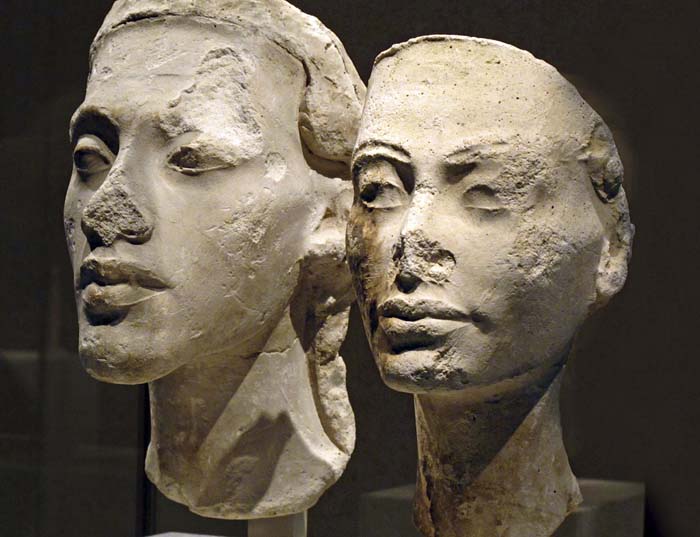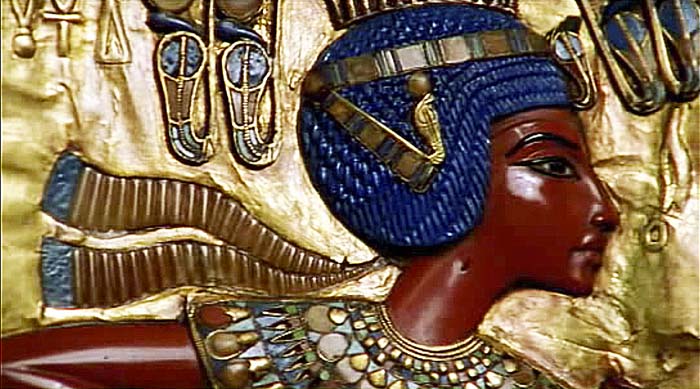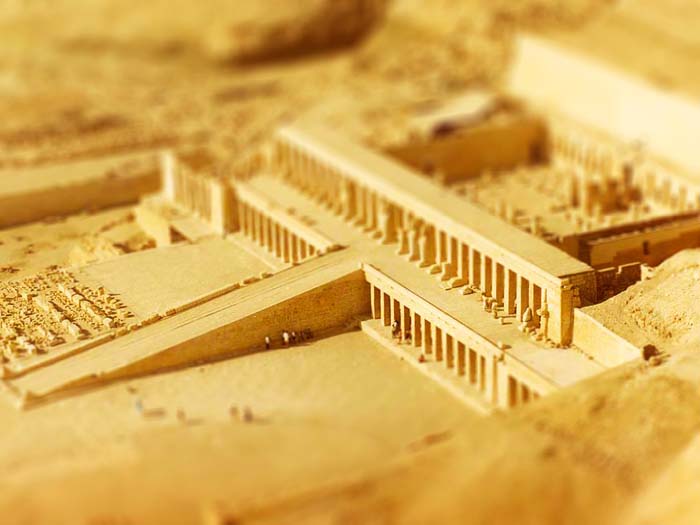Second Intermediate Period (1650-1550)
During the later part of the Middle Kingdom, Asiatic groups moved into the Delta. This period began when Egypt splintered and capitals existed at Avaris, Kush and Thebes. The people groups ruling here were the Asiatics, the Nubians and the Egyptians. One hundred and five royal names from this period exist.
14th Dynasty
This dynasty’s capital was Avaris which was in the Western Delta. The Hyksos, a group of Asiatics, whose names mean “rulers of foreign countries”, ruled here. The origins of the Hyksos are unknown but Avaris’ layout is Syrian. This city had periods of rapid cultural change because of periodic new arrivals from Asia. The rulers used pharaonic titles and their patron god was Set.
15th Dynasty
Avaris was also the capital of this Hyksos dynasty and evidence indicates the throne passed from father to son. The most important pharaoh was Apepi who ruled for at least 40 years. He attacked Memphis to gain control of the Nile and fought with Thebes. Cusae served as the border between the two kingdoms. Evidence of roving bands of mercenaries from each side patrolling the border exists. Avaris and the kingdom of Kush were allies and trading partners.
16th Dynasty
Theban kings contemporary with the 15th Dynasty.
17th Dynasty
This dynasty was also based in Thebes and scholars discovered that at least two of these kings were relatives. The pharaohs had many military officials and their confidence and power were expanding. The first examples of the Book of the Dead date from this dynasty. The bodies of two rulers, Taa and Queen Ahhotep, were in the Deir el-Bahri cache. Priests took some of the royal mummies from desecrated tombs and hid them in two caches near Deir el-Bahri.
The war between Avaris and Thebes lasted for at least thirty years. This was a series of small wars, the first of which was between Apepi and Kamose. Eleven years passed before another campaign because Apepi and Kamose died after their battle. Kamose’s heir, Ahmose I, was a boy when he succeeded. His mother, Ahhotep, served as his regent and kept the kingdom together.
Ahmose I marched north and captured key cities to cut off the Hyksos’ communication lines. He besieged Avaris which took several years to fall. Evidence suggested there was a mass exodus of the inhabitants, not a mass slaughter. Ahmose I reunited Egypt and began the New Kingdom Period.
New Kingdom (1550-1069 B.C.)
18th Dynasty
Ahmose I founded this dynasty and his reign was full of battles. He began several building programs which his son completed. During his reign, evidence indicates there was contact with the Minoans on the island of Crete. Minoan patterns on Egyptian-made objects show this contact. Ahmose I built a palace at Avaris to create a commercial center and worshiped Amun.
Amenhotep I competed his father’s military campaigns and building programs. Amenhotep I and his mother became gods after their deaths and they were the patron gods of Deir el-Medina. This town was the home of the tomb workers who built the Theban tombs and funerary temples. He helped set up the idea of a closed nuclear royal family by decreeing a royal woman could only marry a king.
Thutmose I’s parentage is unknown but his wife’s name was Ahmose so she might have been Amenhotep I’s daughter. Ahmose was the mother of Hatshepsut but not of her husband’s heir, Thutmose II. Thutmose II ruled for a few years and his heir was a child. Hatshepsut was Thutmose III’s regent and later ruled in her own right. She depicted herself as a man, built a beautiful funerary temple and sent a trade mission to Punt. Hatshepsut emphasized her descent from Ahmose I to justify her rule.
Thutmose III campaigned into the Levant and ruled in his own right for over 30 years. He conducted building projects throughout the land of Egypt. At the end of his reign, Thutmose III began to dishonor Hatshepsut’s monuments and erase her name from monuments. He did this to end any claims her family had to the throne of Egypt.
Amenhotep II ruled for around 26 years and expanded temples all over Egypt. He sired more children than his predecessors to insure the line of succession. His son, Amenhotep III, ruled for 38 years in a time of peace and affluence. Royal women gained more important roles in religious rituals. Amenhotep III placed more emphasis on the worship of solar deities and he named his palace “the gleaming Aten”.
Amarna Period
Amenhotep IV built a temple to Aten, the sun-disc, at Karnak during the first years of his reign. In the fifth year of his reign, he built the city of Akhetaten (modern Amarna) and forbade the worship of any god but Aten. Around this time, Amenhotep IV changed his name to Akhenaten. His wife, Nefertiti, held an important role in the new religion. Egyptologists have found Aten temples in several major cities.

© kairoinfo4u – Sculptures of Akhenaton and Nefertiti
The royal family’s depictions show them with unusual features. Their images show them with the Aten, a sun disc with rays coming from them, each with a hand on the end of each ray holding an ankh. The king had a long thin face with a pointed chin and a long neck. He had large, almost female breasts and a protruding belly. The family was often shown hugging and kissing.
Tutankhamun was a child when he inherited and he abandoned Amarna and re-established the worship of the old gods. His successor was Horemheb, a military official but he was gone when Tutankhamun died so Ay took the throne. Tutankhamun’s widow tried to marry a Hittite prince so he could became pharaoh. Allies of Horemheb killed the prince on his way to Egypt and this caused a war with the Hittites.

© tutincommon – Tutankhamun depiction on the back panel of his throne
Horemheb became pharaoh but the length of his reign is unknown. He worked to stamp out lawlessness in the land. Horemheb claimed that Horus chose him to rule Egypt and his death ushered in the 19th Dynasty.
19th Dynasty
The pharaohs of this dynasty saw Horemheb as their period’s founder. Ramesses I was the first pharaoh of this dynasty and his reign was short. He insured that his son, who was an adult when he became pharaoh, inherited. Seti I restored the old religion and re-built Hatshepsut’s funerary temple. He also conducted foreign military campaigns.

© vipez – The Temple of Hatshepsut
Ramesses II began his rule as a co-regent and he deified himself to emphasize his family’s right to rule. He reigned for 67 years and had at least 95 children. Ramesses II conducted extensive building plans or re-appropriated items made by other pharaohs. One of his projects was a giant, multi-room tomb for his children.
Ramesses II fought with the Hittites for several years. He later made peace with them and married a Hittite princess. The rest of his reign was peaceful and he built the city of Piramesse in the Delta to be closer to Asia. Before his death, Ramesses II buried his oldest twelve sons.
Merneptah was the thirteenth son of Ramesses II and he conducted several military campaigns. One of his victory steles contained the first known mention of Israel. Merneptah also had to deal with the invasions of the Libyans and the Sea Peoples.
Tausret was the daughter of Merneptah and the widow of his heir Seti II. Her stepson, Saptah, was a young boy with a bad leg at her husband’s death. Tausret was his regent and might have ruled in her own right for two years. Her death ended the 19th Dynasty.
20th Dynasty
Sethnakht ended the period of civil unrest following Tausret’s death and declared himself pharaoh. His son, Ramesses III, sought to emulate Ramesses II. He used Ramesses II’s throne names and named his sons after his predecessor’s children. Ramesses III had to fend off several invasions by the Sea Peoples.
Some of Ramesses III’s administrative changes caused him, and his successors, problems. He re-organized the agricultural allotments given to the temples. By the end of his reign, one-third of the farmland belonged to the temples. This led to food shortages among the state workers and the first recorded strikes.
As the 20th Dynasty continued, the high priest of Amun gained more power. The pharaoh now had little control over the high priest’s appointment. Many of the kings had short reigns plagued by famine, foreign raids and civil unrest. Beliefs about Amun-Ra changed and he became a distant god. All the other gods and goddesses were manifestations of Amun-Ra. The god was also a personal deity who determined the fates of countries and individuals.

















































